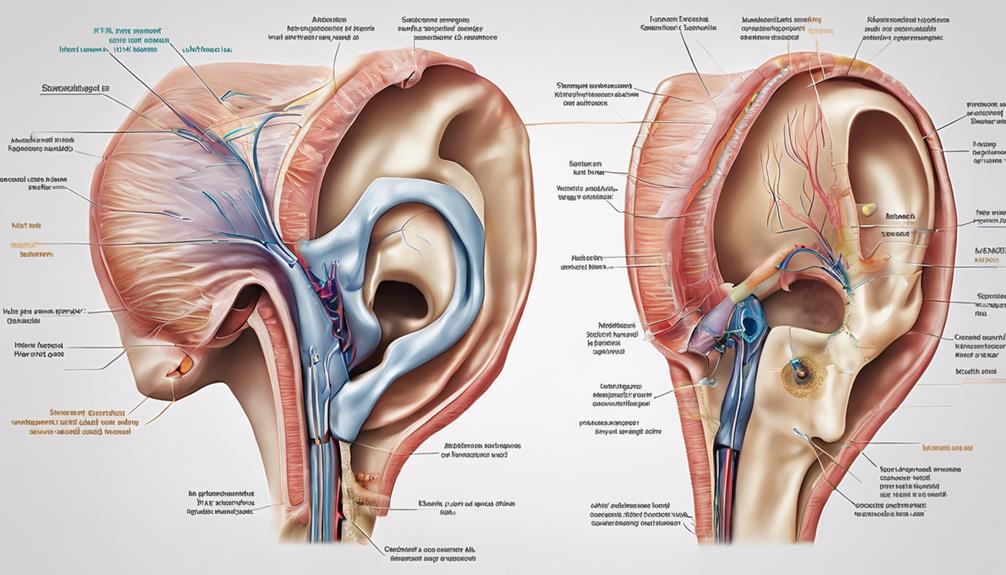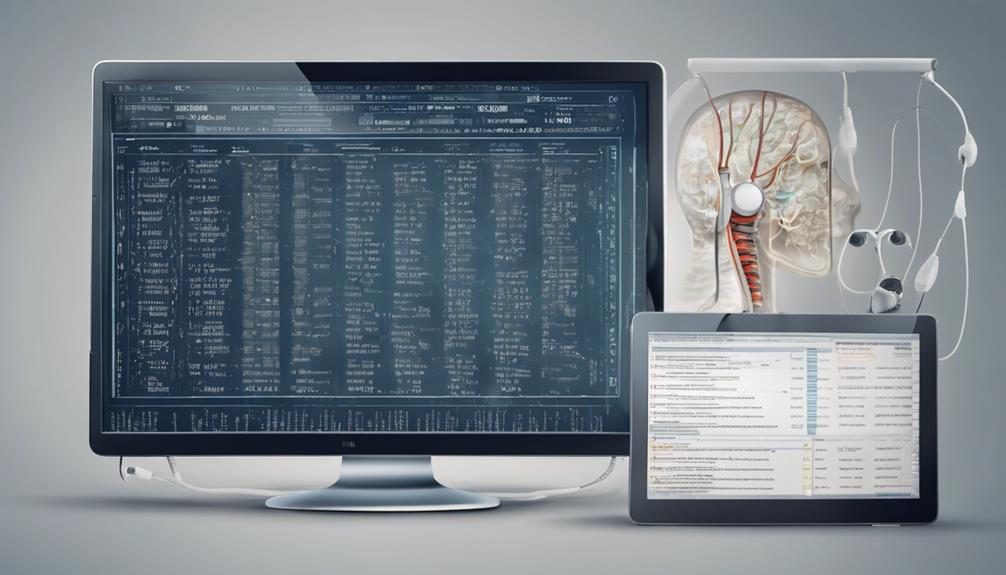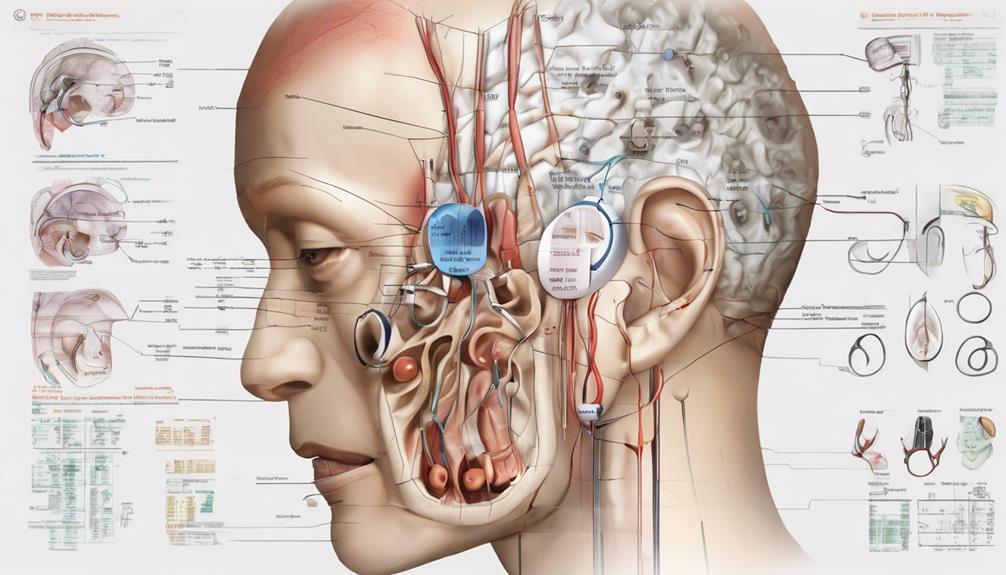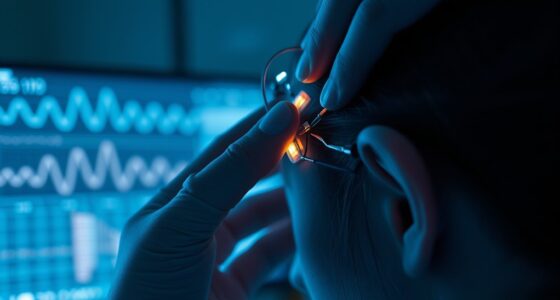Did you know that 1 in every 500 newborns in the United States is affected by sensorineural hearing loss? Understanding the ICD code for bilateral sensorineural hearing loss is crucial for accurate medical records and billing processes.
This specific code plays a significant role in identifying and managing conditions related to hearing loss, but there's more to explore about how it impacts patient care and treatment plans.
Let's uncover the intricacies of coding for bilateral sensorineural hearing loss and why it matters in healthcare practice.
Key Takeaways
- ICD-10 code H90.3 specifies bilateral sensorineural hearing loss accurately.
- Bilateral impairment indicates sensorineural hearing loss in both ears.
- Accurate coding with H90.3 aids in treatment planning and billing processes.
- Understanding coding basics ensures precise documentation for this auditory condition.
Understanding ICD-10-CM Coding Basics
In our examination of Understanding ICD-10-CM Coding Basics, it becomes evident that mastery of this system is fundamental for accurate medical documentation and billing procedures. ICD-10-CM codes, such as code H90.3 for bilateral sensorineural hearing loss, play a crucial role in healthcare settings. These codes serve as a standardized method for classifying various health conditions, enabling healthcare providers to communicate diagnoses effectively and ensure proper treatment planning. Understanding the principles and guidelines of ICD-10-CM coding is essential for healthcare professionals to navigate the complexities of medical documentation and billing accurately.
Proper utilization of ICD-10-CM codes is imperative for ensuring that patients with conditions like bilateral sensorineural hearing loss receive appropriate care and that healthcare facilities receive rightful reimbursement for services rendered. By adhering to coding standards, healthcare practitioners contribute to the overall efficiency and accuracy of the healthcare system, ultimately benefiting both patients and providers. Mastering ICD-10-CM coding basics is a foundational step towards improving the quality of patient care and streamlining billing processes within healthcare institutions.
Bilateral Sensorineural Hearing Loss Overview

Exploring an Overview of Bilateral Sensorineural Hearing Loss, we delve into the intricacies of this condition and its diagnostic code in the ICD-10 system.
Bilateral sensorineural hearing loss, identified by the code H90.3 in the ICD-10-CM, signifies a confirmed diagnosis of sensorineural hearing loss affecting both ears. This specific code is vital as it differentiates bilateral sensorineural hearing loss from other types such as conductive or unilateral sensorineural hearing impairments.
The condition can stem from various factors, including damage to the inner ear or the auditory nerve. Proper coding of bilateral sensorineural hearing loss is paramount for precise medical billing and effective treatment planning. Understanding the nuances of this diagnosis aids healthcare providers in offering targeted interventions and support to individuals experiencing challenges with their hearing.
- Bilateral sensorineural hearing loss is represented by the ICD-10 code H90.3.
- It indicates a confirmed diagnosis of sensorineural hearing loss affecting both ears.
- This code excludes other types of hearing loss like conductive or unilateral sensorineural.
- Bilateral sensorineural hearing loss can result from damage to the inner ear or auditory nerve.
- Proper coding of bilateral sensorineural hearing loss is crucial for accurate medical billing and treatment planning.
ICD Code for Bilateral Sensorineural Hearing Loss

Our discussion now shifts to the ICD code for Bilateral Sensorineural Hearing Loss, highlighting the specific identifier in the medical coding system for this condition affecting both ears. The diagnosis code for this condition is H90.3 in the ICD-10-CM coding system. It is crucial in accurately documenting and billing for cases where individuals are experiencing sensorineural hearing loss in both ears. Here is a table summarizing key details about the ICD-10 code H90.3 for bilateral sensorineural hearing loss:
| Category | Code | Description |
|---|---|---|
| ICD-10-CM Diagnosis | H90.3 | Bilateral sensorineural hearing loss |
| Ear | Both | Affects hearing in both ears |
| Sensory System | Inner | Involves damage to the inner ear or auditory nerve |
| Type of Hearing Loss | Sensorineural | Denotes confirmed sensorineural hearing loss in both ears |
| Prognosis | Permanent | Typically requires interventions like hearing aids or cochlear implants |
Proper utilization of the H90.3 code ensures accurate coding and documentation for cases of bilateral sensorineural hearing loss.
Clinical Diagnosis and Coding Considerations

Considering the clinical manifestation and coding nuances, healthcare providers must accurately document bilateral sensorineural hearing loss using the specified ICD-10 code H90.3. When coding for this condition, it's crucial to provide detailed information to ensure proper classification and tracking. Here are key points to consider:
- Specific ICD-10 Code**: Utilize code H90.3 for bilateral sensorineural hearing loss.
- Involvement of Both Ears: This condition affects both ears, indicating bilateral impairment.
- Inner Ear or Auditory Nerve Damage: Damage to the inner ear structures or auditory nerve pathways contributes to sensorineural hearing loss.
- Specify Side and Diagnostic Certainty: Mention the affected side (e.g., right ear) and the level of diagnostic certainty.
- Accurate Documentation**: Healthcare professionals rely on the ICD-10 code H90.3 to precisely document and monitor cases of bilateral sensorineural hearing loss in patients.
Coding Guidelines for Audiologists and SLPs

Audiologists and speech-language pathologists adhere to specific coding guidelines to accurately classify and document various auditory and speech disorders for effective treatment planning and billing purposes.
When dealing with conditions like conductive and sensorineural hearing loss, utilizing the accurate ICD-10 codes is crucial for proper reimbursement and treatment tracking. For instance, bilateral sensorineural hearing loss is designated by the code H90.3, ensuring precise identification for billing purposes.
In cases of failed hearing screenings for newborns, codes like H91.90 or related options can be used to document these occurrences accurately. Additionally, Z codes play a significant role in capturing factors influencing health status within audiology and speech-language pathology contexts.
When addressing medically-based speech, language, or swallowing issues, classification under the R00-R99 series in ICD-10 coding guarantees meticulous billing and streamlined treatment planning. Adhering to these specific codes and guidelines is essential for audiologists and SLPs to provide comprehensive care and maintain accurate records for coding and billing purposes.
Frequently Asked Questions
What Is the 2023 ICD-10 Code for Sensorineural Hearing Loss?
We, as healthcare professionals, understand the importance of accurate documentation.
The 2023 ICD-10 code for sensorineural hearing loss is H90.3. This code falls under Diseases of the ear and mastoid process. It's specifically designated for bilateral sensorineural hearing loss cases, excluding other types like noise-induced or ototoxic hearing loss.
Properly using this code ensures precise billing and tracking of sensorineural hearing loss in medical records.
What Is Sensorineural Hearing Loss Bilateral?
Bilateral sensorineural hearing loss refers to permanent hearing impairment in both ears due to inner ear or auditory nerve damage. It affects sound transmission to the brain.
Causes include aging, genetics, loud noise exposure, and certain medical conditions. Diagnosis involves audiometry tests for both ears.
Treatment options like hearing aids or cochlear implants aim to improve hearing. It's crucial to address bilateral sensorineural hearing loss early for better management and quality of life.
What Is the ICD-10 Code for Other Hearing Loss Bilateral?
When it comes to ICD-10 coding for other types of bilateral hearing loss, it's crucial to differentiate between sensorineural and conductive causes. Accurate coding ensures proper diagnosis and treatment planning.
For sensorineural hearing loss affecting both ears, the code H90.3 is utilized. Understanding these distinctions is essential for healthcare providers to effectively manage and document various types of bilateral hearing loss.
What Is H90.0 Bilateral Cholesteatoma?
We understand the importance of accurate coding for medical conditions.
When addressing the query about 'h90.0 bilateral cholesteatoma,' it's vital to distinguish between coding for hearing loss and cholesteatoma. Cholesteatoma, represented by code H90.0, refers to the presence of skin growth in the middle ear.
While bilateral sensorineural hearing loss is a separate condition, correct coding ensures precise treatment and billing.
Accuracy in assigning ICD codes is crucial for effective healthcare management.
Conclusion
In conclusion, the ICD-10 code for bilateral sensorineural hearing loss, H90.3, plays a crucial role in accurately diagnosing and managing this condition.
By understanding the coding basics and considering clinical diagnosis guidelines, healthcare professionals can effectively document and treat patients with hearing loss.
With proper coding practices, audiologists and SLPs can provide comprehensive care and support to individuals experiencing bilateral sensorineural hearing loss.











